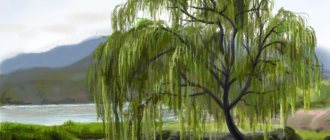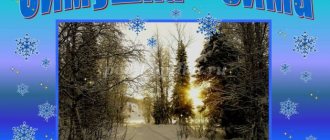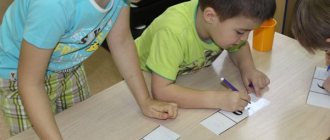Lesson summary for the senior group on the Federal State Educational Standard “Oh, you winter-winter”
Summary of an integrated lesson in accordance with the requirements of the Federal State Educational Standard in the senior group on the topic “Oh, you winter-winter”
Author: Mandrykina Irina Nikolaevna, teacher. Goal: Repetition and generalization of acquired skills and abilities, clarification of children’s acquired knowledge in educational fields. Objectives: Educational:
1. Learn to express your point of view, listen to peers and maintain a conversation.
2. Activate children's vocabulary. 3. To consolidate in the minds of children the signs of winter and seasonal changes in nature. Developmental:
1. Develop memory, thinking, attention, sense of beauty through the winter landscape and the ability to convey this in your work.
2. Contribute to the preservation and strengthening of children’s health. 3. Develop children’s ability to communicate with adults and peers. 4. Develop independence, focus and self-regulation of one’s own actions. 5. Develop responsiveness, curiosity, cognitive motivation. Educational:
1. To form in children a sense of cohesion, unity, and a positive emotional mood within the team.
2. Strengthen children’s ability to interact with each other in a short game. 3. Strengthen the ability to follow the rules of the game, line up in a circle, find your place when building, move together, don’t push. Integration of educational areas: - Social and communicative development; — Cognitive development; — Artistic and aesthetic development; — Speech development; - Physical development. Methodical techniques: Game demonstration, comparison, questions, generalization. Providing activities: For the teacher:
a snowman, a painting “Winter Sorceress”, a painting with a winter landscape for group decoration, paper snowflakes for group decoration, imitation of snowdrifts.
For children:
drawing equipment: brushes, paints, watercolor sheets, napkins, coasters, sippy cups, wax crayons.
Progress of joint activities
Motivational and incentive stage: Exercise “Give a smile to a friend”:
Hello, the sky is blue!
(hands up) Hello, golden sun! (hands up) Hello, mother earth! (hands down) Hello, my friends! (arms to the sides) Educator: We have guests today, let's say hello to them. Organizational - search stage: Educator: Today a lot of interesting things await us, and your attention, resourcefulness, ingenuity and curiosity will help you. Please guess the riddle: Every day it’s getting colder, The sun is warming less and less, There’s snow everywhere, like a fringe, - So, it’s come to us... (winter) - What time of year do you think we’ll talk about? — What time of year is it now? Name the winter months. What is our winter like? (winter is snowy, cold, frosty) What happens in winter? (snow is falling, the wind is howling, the river is freezing) What can you say about snow? (the snow is fluffy, light, soft. The snow covered the whole earth. What is the weather like in winter? (the weather in winter is windy, frosty, snow is blowing in winter, the wind is howling) - They described winter well, remembered all its signs. Let us play a little. Game " "Winter words" Children clap their hands if they hear a word associated with winter (Snowflake, warmth, New Year, sled, ice, heat, mittens, tulips, snowman, Santa Claus, falling leaves, Snow Maiden, strawberry, sunbathing, snowfall, skiing ". Game "Say a word" (related words) - In winter, everything is covered with white fluffy snow, let's play with this word. The teacher reads a poem, and the children add words related to the word "Snow". Quietly, quietly, as in a dream, it falls to the ground (snow) From the sky all the fluffs are sliding - silvery (snowflakes) In the village, on the meadow everything is falling (snowball) Here's fun for the guys - more and more (snowfall) Everyone is running to the races, everyone wants to play ... (snowballs) Like in dressed up in a white down jacket (snowman) There’s a snowy figure nearby - it’s a girl (snow maiden) In the snow - look? - with a red breast (bullfinches) As if in a fairy tale, as in a dream, the whole earth was decorated (snow) - What words did you add? - What word do they all look like? Who knows what to do outside in winter to avoid freezing? That's right, move! And now I suggest you get up and move. Physical exercise “Making a snowman” with music - Guys, tell me, what else do you like to do while walking? (children call) - Today we will talk about one of the winter activities. Listen carefully to the riddle: They didn’t raise me, They made me out of snow, Instead of a nose they cleverly inserted a carrot. Eyes - coals, Hands - knots, Cold, big. Who am i? (Snowman) (show a picture of a snowman). — Do you think it’s interesting to sculpt snowmen? Presentation “Snowman: the history of the origin of the symbol of winter and the New Year” Educator: We will continue to master mixed media in drawing - wax chalk and watercolor. Of course, your snowmen will be similar to each other, because each snowman consists of... what? Children: From balloons. Educator: How many snow globes do you need for a snowman? Children: Three. Educator: What size are these balls and how are they located? Children: A snowman consists of three balls placed on top of each other; at the bottom is the largest one, in the middle is the medium-sized one, at the top is the smallest one - this is the head; hands can be made from ovals. Educator: What items of clothing can you draw for a snowman? Children: Beautiful hats and scarves. First, we will do some finger exercises. Finger game “Winter” We put our palms out, (Children put their hands forward with their palms up) We begin to catch snowflakes! (Children perform grasping movements with their hands - “catch” snowflakes.” One, caught, two, caught! Not tired? Not tired! (children “catch” snowflakes) One, caught, two, caught! And of course, not tired! And snowflakes a lot, a lot! (children make “waves” with their hands, with their palms “looking” down) And snowdrifts grow everywhere. (children show with their hands with outstretched fingers “growing snowdrifts”) Let’s collect snow in our palms (children show how they collect with both hands a handful of snow) And let’s start making snowballs! (they begin to “make” snowballs) We sculpt, sculpt, sculpt a ball (the children continue to “make” snowballs) And then we throw it up! (an imaginary snowball is thrown up) We played without a care, And now we hurry to work! (everyone returns to work) Educator: We outline the outline of the snowman with white wax chalk, paint over the body, red cap and carrot, brown handles and you can draw a panicle. We tint a sheet of paper with blue paint. Result of the lesson: Educator: Guys, tell me, did you like our lesson? - What Did you like our lesson? — What caused the difficulties? - What have you learned? — What new did you learn? Thank you for the lesson.
Presentation on the topic: Snowman. The history of the symbol of winter and New Year
We recommend watching:
Summary of an integrated lesson in the senior group Integrated lesson in the middle group using ICT “Birds” Summary of the final integrated lesson on speech development and artistic creativity in the senior group Summary of a mathematics lesson in the senior group on the topic: Winter
Similar articles:
Summary of an integrated lesson on the topic “Trees” in the senior group
Summary of an integrated lesson – travel on the topic “Winter” in the senior group
Walk “Wind Watching” in the senior group
Observation in the senior group of kindergarten. It's frosty outside
Summary of an integrated lesson in the senior group of kindergarten “Hello, Zimushka-winter!”
Summary of an integrated lesson in the senior group “Hello, Zimushka-winter!” Target:
— Development of creative initiative and independence of children, the desire to apply existing knowledge and skills in practice.
Objectives: Educational:
- enrich the emotional and aesthetic perception of preschool children through the poetic word and music;
- to develop the ability to dramatize simple poetry: to combine movement and text in the role - to introduce children to and help them master unconventional drawing techniques (with a sponge on a stencil); Developmental:
- develop creative imagination, fantasies, thinking, memory, the ability to see, feel, discuss winter fun;
Educational:
- cultivate positive relationships in children, feelings of partnership, friendship and responsibility.
Materials:
costumes of Snowman, Wolf, hats of hares, Winter, oilcloth, sponges, brushes, baths of gouache, stencils of wolves, hares, snowmen, napkins, three sheets of whatman paper in A1 format, with a prepared background.
Preliminary work:
memorizing poems about snowmen, songs, dances, expressive reading of memorized poems.
Progress of OOD Children enter the music room to the music, forming a circle. Educator:
Winter rolled over us with snowy sleeves, And snowflakes fell on the trees and houses.
We will fight in the snow, We love to ride down the mountain And that’s why we really like it Children (in unison):
I really like winter!
Educator:
Since you like winter, let's sing a funny song about it.
(children stand up scattered and perform a song with movements) “Winter Song” (music - V. Vitlina, words - T. Volchina) 1 child: Oh, you're winter - winter, We're glad that you came. Let's start a round dance and sing a winter song. Round dance “Hello, winter-winter! "(music - A. Filippenko, words - T. Volchina). Child 2: (reads a counting rhyme, chooses a driver for the game) We begin to play, We will count everyone in a row: One, two, three, four, five, We will choose winter. (The selected child puts on a Winter hat) Game “Winter and Children” (author unknown) Children (in chorus): One, two, three, four, five, Come on Winter, hurry up and play. (Winter in the center of the circle) Winter, winter, where have you been? (Children approach Winter, narrowing the circle, Winter, winter, where have you been? expand the circle, then repeat the movements that Winter shows) Winter: She carried cold in a bag, (Winter walks, depicting a bag over her shoulder, shook the cold on the ground, shakes her hands away from herself, her arms and legs are chilly, she rubs her shoulders with her palms, shifts from foot to foot, she lets the cold into the hut, blows, makes smooth movements with her hands forward, all the roads of the earth smoothly shakes her hands below, and the snowdrifts raises her hands up, through sides returns them to their original position) Children (in chorus): Oh, you're Winter-winter, (Children narrow the circle, It was a fierce winter, expand the circle, I ask you, stretch their arms forward, Don't freeze me! They shake their fingers) After these words, the children They run in a circle towards the chairs, Winter tries to catch up and “freeze” as many children as possible. Educator:
And now, I’ll tell you a riddle.
Children sculpt in winter a Miracle with a round head: Who will deftly place on whom, A riddle - The mouth is an arc, and the nose is a carrot, And two eyes are coals, And two hands are made from branches. The sun came out, and he wilted. Who is this? (Snowman) We taught you a lot of poems about snowmen. Let's try to not only read them now, but also show them (dramatization of poems) “Snowman” (author - V. Egorov) - 3 boys, Come on, my friend, be brave, my friend, Roll your snowball in the snow. He will turn into a snowball, And the ball will become a snowman. His smile is so bright! Two eyes, a hat, a nose, a broom. But the sun will burn slightly - Alas! - and there is no snowman. “Snowman” (author - T. Shorygina) - 2 girls and a boy, My friend Katya and I are rolling big time. We make a snowman from a fluffy ball. In a white fur coat, With coals instead of eyes, Smiling as if alive, the Snowman looks at us. We will give him a broom, We will mold a fluffy collar, Let a janitor - a snowman - walk along the streets of the village. Educator:
Now let's listen to a story in which another snowman showed himself bravely.
“Snowman” (author - I. Gurina) - (reading a poem with dramatization by roles: author, 5 hares, snowman, wolf (8 children) White bunnies were sitting on the stump of an old fir tree. - What should we do with this? - They reasoned sadly brothers." - And we played in the snow, And rode on the slide! And let's, maybe, sculpt Baba in the snow! Exactly! We got down to business, And the work began to boil! Five of the bunnies were rolling a huge snowball. The second one was easier, The third one was the younger brother blinded! The hands are two large sticks, And the hairstyle is made of a washcloth. The cheerful nose is made of carrots, The eyes and eyebrows are made of knots. The mouth and cheeks are made of rowan, The hat is made of a large basket. The bunnies are jumping around: - Hello, hello, snowy friend!" He suddenly nodded his head and winked at the bunnies: "Would you like the bunnies to play hide and seek with me?" The elder twists his head: "Our snowman is alive!" At that time, behind the bushes, a gray wolf was clanking his teeth. Only he jumped to the bunnies! And a snowman came along! The wolf was terribly frightened, The snowman chased him. What kind of snowy beast is this wandering through the forest now? The wolf moans quietly out of fear, He won’t touch any more hares, After all, the brothers have a new friend, He is stronger than everyone around! Educator:
After watching this story, you probably really wanted to draw it on paper.
But first, let's do the wonderful "I Draw" dance. Dance “I Draw” (to the music “Winter” disc “New Year’s Snowflakes” Publishing House Vest - TDA Moscow) Educator:
Now we will begin to draw a winter story about a brave snowman in an unusual way using stencils and sponges. You need to press the stencil tightly with your left hand, and apply paint with your right hand using a sponge. You also need to choose 2 people who will complete the winter landscape with a brush of white paint. Divide into three subgroups and get to work. Children draw to the music of P. I. Tchaikovsky from the cycle “The Seasons”; after finishing drawing, the children examine the drawings. Educator: Children, what works did you like and why? (children's answers) Well done, guys, you have created wonderful illustrations for the winter story with the snowman. Tell me, children, what did you like about the lesson? (children's answers). Well, now let’s smile at each other and get ready for a walk in a good mood, where we’ll come up with new stories with crafts made from snow.
Snowflake No. 5
Guys, the Winter Sorceress has prepared the following task for you: draw a snowflake. This snowflake is magical, it will not melt because it is drawn on paper.
(Show the snowflakes shown in the pictures).
To do this, we need these sheets of blue cardboard, glue and brushes, and also salt. Draw a snowflake on a sheet of cardboard with glue, and then sprinkle salt on the glue. Press the salt with your palm. The excess must be shaken off. These are the wonderful snowflakes you can now draw. Well done boys!
(During children’s independent activities, music is turned on).
We will decorate our area (our group) with these snowflakes.
Snowflake No. 4
There are words that are similar, Like relatives that are similar, They live as one family, They want to play with you.
Educator: Do you want to play?
The game is called "Agree a Word."
- Quietly, quietly, as if in a dream, it falls to the ground.... (snow).
- Silvery fluffs keep sliding from the sky... (snowflakes).
- On the country roads, on the meadow, everything goes down... (snowball).
- The earth was white, clean, tender, covered with a bed... (snowy).
- This is fun for the guys - everything is getting stronger... (snowfall).
- Everyone is running a race, everyone wants to play ... (snowballs).
- Snowball - on a snowball, everything was decorated... (with a snowball).
- It’s as if we were wearing a white down jacket…. (snowman).
- Nearby is a snowy figure, it’s a girl... (Snow Maiden).
Educator: While we were playing, it snowed heavily and snowflakes flew to us. Look what they are?
Do you want the snowflakes to spin? (Yes)
- Then you need to blow on them (slowly draw air through your nose. Don’t puff out your cheeks, stretch out your lips like a “tube”) and blow on the snowflakes.
(children perform the “Snowflakes” exercise 3-5 times
Educator: Well done, guys!





